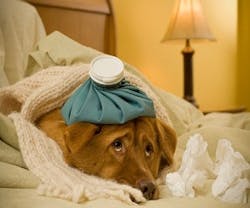Is Your Facility Ready for Flu Season?
Is your facility ready to handle flu season? Think again - The U.S. Department of Health estimates that five to 20% of Americans will contract the flu each year, with more than 200,000 hospitalized for flu-related complications.
To help combat flu-causing organisms, Cintas Corporation has announced five disinfection strategies for targeting germ hotspots. By identifying the main areas where viruses and bacteria thrive, the tips can assist facility managers with disinfection efforts, keeping building occupants safe and healthy throughout the flu season.
Cintas offers the following germ hotspot disinfection tips:
1) Disinfect high-touch surfaces
The Journal of Medical Virology estimates that viruses and bacteria can remain on hard surfaces for up to 18 hours. To reduce illness, ensure that high-touch surfaces such as door handles, desks, keyboards and phones are disinfected regularly. Use a combination of anti-microbial cleaners and disinfectants to remove and kill pathogenic micro-organisms that thrive in these areas. Increase cleaning frequencies of high-touch surfaces during the flu season to protect guests and staff against infection.
2) Deep clean restrooms
The buildup of harmful germs in restrooms can easily transfer to guest hands and cause illness. To thoroughly sanitize restroom surfaces, implement a deep cleaning system that reaches all corners and sanitizes grout lines, walls, sinks, faucets and commodes. Combining high-pressure equipment and industry-grade chemicals will thoroughly remove harmful bacteria from restroom surfaces.
3) Be mindful of matting
While matting can be an effective method to trap and contain germs, soiled floor mats can be a breeding ground for harmful bacteria and microbes. In fact, research has shown that about 96 percent of footwear contains traces of fecal matter and dangerous bacteria. To ensure that illness-causing bacterium doesn’t transfer back onto shoes or into air, keep matting in top condition. Partner with a matting service provider and develop a weekly laundering schedule to ensure that matting stays clean and effective in removing bacteria from footwear.
4) Don’t forget flooring
Flooring can contain more than 2 million bacteria per square inch, making it one of the top germ hotspots. To reduce overall bacteria levels throughout the facility, use clean mops and tools specifically designed to prevent cross contamination by separating dirty water from clean water. A mop service will replace soiled mops with clean mops on a weekly basis to ensure that tools are always in top condition.
5) Promote hand washing
With more than 50,000 bacteria per square inch, hands are an area where germs commonly thrive. Encouraging frequent hand washing is the single most effective method for reducing the spread of illness among guests and employees. Provide anti-microbial hand soap at employee and guest sinks throughout the facility. Center-pull paper towel dispensers reduce contact between hands and dispensing units to provide an added level of protection against bacteria. In areas without sinks, consider installing hand- sanitizer dispensers or disinfecting wipe stations. Remind employees and guests about the importance of hand washing and how they contribute to infection-prevention programs.
